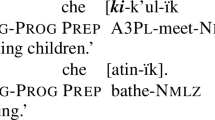Abstract
In the literature on the argument structure of nominalizations, one can find mainly two approaches: the first approach (e.g., Grimshaw 1990) assumes that argument inheritance is restricted to event nominals or event-related nominals, whose inherited arguments are obligatorily realized. This view contrasts with the assumption in the second approach that all arguments of the base verb are inherited by the nominal unless they are explicitly bound, but that internal arguments of the noun/nominal are optional (e.g., Bierwisch 1989). The first approach predicts noun-verb asymmetries in argument linking for the class of non-event nominals, while the second approach predicts that the argument linking of nouns/nominals differs from that of verbs in general.
Classical Nahuatl, an Uto-Aztecan language, provides evidence against both approaches: in all classes of nominals (event, agent, instrument, locative, and internal argument nominals), unspecific affixes saturate arguments in the base verbs and the derived nominals, independent of whether an event reading is possible or not. Only under the assumption of obligatory argument inheritance can the distribution of active and inactive stems and the distribution of reflexives be explained for the nominals. I will show that none of the nominals fall under the notion of ‘mixed categories’ (such as English gerunds), which are expected to display a verb-like argument linking.
Similar content being viewed by others
REFERENCES
Andrews, J. Richard: 1975, Introduction to Classical Nahuatl, University of Texas Press, Austin.
Asher, Nicholas: 1993, Reference to Abstract Objects in Discourse, Kluwer, Dordrecht.
Baker, Mark: 1996, The Polysynthesis Parameter, Oxford University Press, Oxford.
Bierwisch, Manfred: 1983, ‘Semantische und konzeptuelle Repräsentation lexikalischer Einheiten’, in Rudolf Ruzicka and Wolfgang Motsch (eds.), Untersuchungen zur Semantik, Akademie Verlag, Berlin, pp. 61–99.
Bierwisch, Manfred: 1989, ‘Event Nominalization: Proposals and Problems’, Linguistische Studien 194, Akademie der Wissenschaften der DDR, Berlin, pp. 1–73.
Bierwisch, Manfred and Ewald Lang (eds.): 1987, Grammatische und konzeptuelle Aspekte von Dimensionsadjektiven, Akademie-Verlag, Berlin.
Booker, Karen M.: 1980, Comparative Muskogean: Aspects of Proto-Muskogean Verb Morphology, unpublished Ph.D. dissertation, University of Kansas.
Bresnan, Joan and Lioba Moshi: 1990, ‘Object Asymmetries in Comparative Bantu Syntax’, Linguistic Inquiry 21, 147–185.
Campbell, Lyle: 1985, The Pipil Language of El Salvador, de Gruyter, Berlin.
Carochi, Horacio: 1645, Arte de la lengua mexicana: con la declaración de los adverbios della, Reprinted 1983 by Universidad Nacional Autónoma de México.
Fanselow, Gisbert: 1991, ‘Ein modulares Konzept der Lexikonerweiterung’, Working Papers of the SFB 282 ‘Theory of the Lexicon’ 6, University of Cologne, pp. 1–32.
Grimshaw, Jane: 1990, Argument Structure, The MIT Press, Cambridge, Massachusetts.
Heath, Jeffrey: 1998, ‘Pragmatic Skewing in 1 ↔ 2 Pronominal Combinations in Native American Languages’, IJAL 64/2, 83–104.
Kaplan, Ronald M. and Joan Bresnan: 1982, ‘Lexical-Functional Grammar: A Formal System for Grammatical Representation’, in Joan Bresnan (ed.), The Mental Representation of Grammatical Relations, The MIT Press, Cambridge, Massachusetts, pp. 173–281.
Karttunen, Frances: 1992, An Analytical Dictionary of Nahuatl, The University of Oklahoma Press.
Kiparsky, Paul: 1992, ‘Structural Case’, Unpublished ms., Center for Advanced Studies, Berlin.
Kimenyi, Alexandre: 1980, A Relational Grammar of Kinyarwanda, University of California Press, Berkeley.
Lakämper, Renate and Dieter Wunderlich: 1998, ‘Person Marking in Quechua: A Constraint-based Minimalist Analysis’, Lingua 105, 113–148.
Langacker, Ronald W.: 1976, Non-distinct Arguments in Uto-Aztecan, University of California Press, Berkeley.
Launey, Michel: 1979, Introduction à la langue et à la litterature Azteques, vol. 1: Grammaire, L'Harmattan, Paris.
Launey, Michel: 1998, ‘Compound Nouns vs. Incorporation in Classical Nahuatl', paper presented at the workshop on ‘Problems of Polysynthesis', Cologne, 9–11 October.
Levin, Beth and Malka Rappaport: 1988, ‘Non-event er-Nominals: A Probe into Argument Structure', Linguistics 26, 1067–1083.
McCarthy, John and Alan Prince: 1993, ‘Prosodic Morphology I: Constraint Interaction and Satisfaction', unpublished ms., University of Massachusetts, Amherst, and Rutgers University.
McCarthy, John and Alan Prince: 1995, ‘Faithfulness and Reduplicative Identity', in Jill N. Beckman, Laura Walsh, and Suzanne Urbanczyk (eds.), Papers in Optimality Theory, University of Massachusetts Occasional Papers 18, pp. 249–384.
Ortmann, Albert: 1994, ‘Possessorkongruenz: Eine Fallstudie zum Verhältnis von Semantik, Morphologie und Syntax', unpublished Master's thesis, University of Düsseldorf.
Pittman, Richard Saunders: 1954, ‘A Grammar of Tetelcingo (Morelos) Nahuatl', Ph.D. Dissertation, University of Pennsylvania. Published as Language 30/1, Supplement.
Rappaport Hovav, Malka and Beth Levin: 1992, ‘-er Nominals: Implications for a Theory of Argument Structure', in Tim Stowell and E. Wehrli (eds.), Syntax and Semantics 26: Syntax and the Lexicon, Academic Press, New York, pp. 127–153.
Stiebels, Barbara and Dieter Wunderlich: 1994, ‘Morphology Feeds Syntax: The Case of Particle Verbs', Linguistics 32, 913–968.
Sullivan, Thelma: 1988, Compendium of Nahuatl Grammar, The University of Utah Press, Salt Lake City.
Wunderlich, Dieter: 1993, ‘On German um: Semantic and Conceptual Aspects’, Linguistics 31, 111–133.
Wunderlich, Dieter: 1994, ‘Towards a Lexicon-Based Theory of Agreement’, Theoretical Linguistics 20, 1–35.
Wunderlich, Dieter: 1997, ‘Cause and the Structure of Verbs’, Linguistic Inquiry 28, 27–68.
Author information
Authors and Affiliations
Rights and permissions
About this article
Cite this article
Stiebels, B. Noun-verb Symmetries in Nahuatl Nominalizations. Natural Language & Linguistic Theory 17, 783–834 (1999). https://doi.org/10.1023/A:1006254405050
Issue Date:
DOI: https://doi.org/10.1023/A:1006254405050




